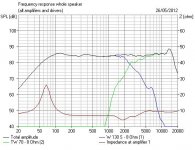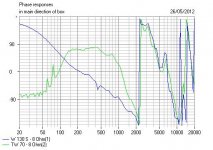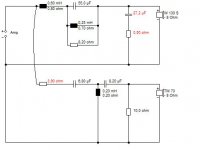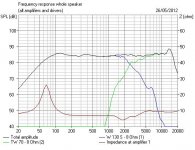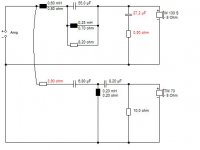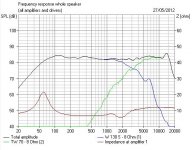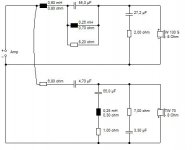Pallas,
You may not be concerned,M & M may not be concerned, but that does not mean I can't clearly hear issues. If you can't, you are very lucky as you can spend a ton less money than I to be happy. I happen to actually know how to use my DCX, so the kind of stupid "looks good on paper" and automatic AVR push button garbage over-boost does not apply. Just for a reference, I use no eq on my main subs. Rather I was careful in their design, the room placement, and the bass traps.
Some of the things you can do in active crossovers are very deep notches and higher order filters than one would want to attempt in passive. You can have far more fun with phase shift all-pass and even time delay that you could not do in passive. If you want to manage the load on the amp, you have to do that passive.
Again, there is no single correct or incorrect answer. Only a lot of design choices that solve the problems most important to you. I may solve different problems.
You may not be concerned,M & M may not be concerned, but that does not mean I can't clearly hear issues. If you can't, you are very lucky as you can spend a ton less money than I to be happy. I happen to actually know how to use my DCX, so the kind of stupid "looks good on paper" and automatic AVR push button garbage over-boost does not apply. Just for a reference, I use no eq on my main subs. Rather I was careful in their design, the room placement, and the bass traps.
Some of the things you can do in active crossovers are very deep notches and higher order filters than one would want to attempt in passive. You can have far more fun with phase shift all-pass and even time delay that you could not do in passive. If you want to manage the load on the amp, you have to do that passive.
Again, there is no single correct or incorrect answer. Only a lot of design choices that solve the problems most important to you. I may solve different problems.
300Hz Boundary
There is a boundary that divides drivers and that is 300Hz.
20Hz to 300Hz
300Hz to 20kHz
Kindly agree or disagree
There is a boundary that divides drivers and that is 300Hz.
20Hz to 300Hz
300Hz to 20kHz
Kindly agree or disagree
I work from this observation these days:
An externally hosted image should be here but it was not working when we last tested it.
This is not true because the load presented by the second woofer is Le+Re and you can not separate Re from Le. You can not look at the voltage across Re alone. The circuit shown yields a 2nd order LP across the second woofer, not 3rd order. Additionally, the voltage across the first woofer is shelved down by the voltage divider effect below the x-o point and rises to flat above it. The summed response is the same as that of a single, unfiltered woofer.
There is a boundary that divides drivers and that is 300Hz.
20Hz to 300Hz
300Hz to 20kHz
Kindly agree or disagree
300 Hz is used as a common woofer to mid crossover point because of floor bounce effects. By keeping the woofer close to the floor and the mid a couple of feet above it floor bounce can be minimized with the crossover around 300 Hz or so. It has nothing to do with drivers. It has to do with where the drivers are mounted relative to the ground plane.
Pallas,
You may not be concerned,M & M may not be concerned, but that does not mean I can't clearly hear issues.
Hear issues with what, an AD/DA loop?
I don't doubt that you think you can "hear" the issue. (And maybe the gain structure of your system with the Behringer box thrown in is sufficiently messed up that you are hearing something amiss. Or its analog circuitry is noisier than that of the miniDSP's I use) However, before you spout off you should probably read Meyer and Moran. And if you run similarly controlled tests and come to a different result, write them up for publication. That would be interesting.
But absent that, I'm inclined to just say "you're full of it" and move on. Right now all we have is your speculation, against peer-reviewed data from a long-term study by very sophisticated audiophiles of the Boston Audio Society.
Just for a reference, I use no eq on my main subs. Rather I was careful in their design, the room placement, and the bass traps.
Bass traps? Unless you've treated whole walls with lossy damping, don't make me laugh. The little foamy things don't do anything, except make a room look tacky.
How about you show us measurements of your subwoofer system?
For reference, you may find two of mine here. One was in a room that had lossy walls, and I was able to place the subs so as to require no EQ. Just control over relative levels and phase/delay. The other was in a room with more substantial walls, and also required some EQ because two of the subs were fairly high-tuned (~40Hz) passive radiator units.
That said, while with a lucky room (or the ability to build false lossy walls) and great placement/setup EQ is not always needed in the bass. EQ ("passive" or "active") is almost always needed somewhere in the main channels, to help bring down cone breakup, or make the crossover region smoother, or compensate for HF rolloff in compression drivers, or deal with various other things that crop up in a mechanical system.
Again, there is no single correct or incorrect answer. Only a lot of design choices that solve the problems most important to you. I may solve different problems.
If you don't solve the problem of "how do I constrain the directivity of the tweeter to match that of the next-driver-down in the crossover region," then you simply aren't even looking at the problem of "how does one get high-fidelity midrange reproduction." And as goes the midrange, so goes the music. By contrast, an AD/DA loop that allows access to easy-to-use and very sophisticated digital processing is just an utter non-issue, that I don't even know where to start.
PS: I have an innate preference for passive filters, simply because they allow one to have fewer electronic boxes in the living room: one amp channel per speaker. However, in practice I use active DSP filters because they are so easy to dial in, and also doing A/B comparison is much easier when one just has to press a button, as opposed to installing a new network. So more junk in the room, but fewer bins of various passive parts in varying values sitting in a box in the storage closet.
Last edited:
Bass traps? Unless you've treated whole walls with lossy damping, don't make me laugh. The little foamy things don't do anything, except make a room look tacky.
If you think all bass traps are 'little foamy things' you have a LOT to learn about room treatment in general and bass traps in particular.
Google is your friend here or may be a pro sound forum such as gearslutz.com.
Naturally I realised that John. You're the first person paying sufficient attention to point that out. Even Lynn missed it. But then you know how close a second order Linkwitz-Riley is to a third order Butterworth in various senses. 🙂This is not true because the load presented by the second woofer is Le+Re and you can not separate Re from Le. You can not look at the voltage across Re alone. The circuit shown yields a 2nd order LP across the second woofer, not 3rd order. Additionally, the voltage across the first woofer is shelved down by the voltage divider effect below the x-o point and rises to flat above it. The summed response is the same as that of a single, unfiltered woofer.
Nevertheless, it's an interesting observation that the optimum filter is intimately related to the driver's properties. It's also interesting that a driver has a natural rolloff and crossover frequency related to its voice coil inductance IMO. 🙂
Mondo and I have been getting quite excited about some of the the deceptively ordinary looking Visaton cone drivers lately. The TW70 is very nice, only let down by slight dispersion problems at high frequency:
Visaton - Lautsprecher und Zubehör, Loudspeakers and Accessories
The TW6 does better, but is tonally a bit worse:
Visaton - Lautsprecher und Zubehör, Loudspeakers and Accessories
The Rolls_Royce driver seems to be the fullrange FRS 5x8 which works really well with 2nd order time aligned:
Visaton - Lautsprecher und Zubehör, Loudspeakers and Accessories
Meantime I've been modelling the TW70 with the W130S, and getting great results with second order bass and third order tweeter in conventional flat-baffle BBC type tiny 12L bookshelf. Very reminiscent of the Acoustic Research AR-7 which I know speaker dave is familiar with and has modified in its AR-4 version. Notice how the crossover uses natural voice-coil inductance and near Zobel capacitance.
An externally hosted image should be here but it was not working when we last tested it.
BTW, back on-topic, second order is good, but do consider third order now and then. It's whatever works really! 🙂
Attachments
i agree. RE the FRS5X though, with many tweeters id use 2nd order, like somebody else said earlier in this thread i think, the natural roll off of the driver can be used to create a higher order acoustic HP filter. In the case of a conventional 2 way crossover point, you are getting close to a 2nd order acoustic with a wideband driver, crossing at 2k Im trying to use a lower crossover point with 2nd order around 500hz. At normal levels they cope with this fine. Party volume capability, is less likely without a higher turnover, or steeper filter. 0My greater point being that these drivers id consider 3rd order, in almost all my other past projects i used 2nd order.
Last edited:
BTW, back on-topic, second order is good, but do consider third order now and then. It's whatever works really! 🙂
And I thought you were a hardcore first order guy! Nice simulations with good phase overlap.
David
There is a boundary that divides drivers and that is 300Hz.
20Hz to 300Hz
300Hz to 20kHz
Kindly agree or disagree
I am wondering by what criteria you make this assumption? Every driver has a suitable range.
Hear issues with what, an AD/DA loop?
I don't doubt that you think you can "hear" the issue. (And maybe the gain structure of your system with the Behringer box thrown in is sufficiently messed up that you are hearing something amiss. Or its analog circuitry is noisier than that of the miniDSP's I use) However, before you spout off you should probably read Meyer and Moran. And if you run similarly controlled tests and come to a different result, write them up for publication. That would be interesting.
But absent that, I'm inclined to just say "you're full of it" and move on. Right now all we have is your speculation, against peer-reviewed data from a long-term study by very sophisticated audiophiles of the Boston Audio Society.
Bass traps? Unless you've treated whole walls with lossy damping, don't make me laugh. The little foamy things don't do anything, except make a room look tacky.
How about you show us measurements of your subwoofer system?
For reference, you may find two of mine here. One was in a room that had lossy walls, and I was able to place the subs so as to require no EQ. Just control over relative levels and phase/delay. The other was in a room with more substantial walls, and also required some EQ because two of the subs were fairly high-tuned (~40Hz) passive radiator units.
That said, while with a lucky room (or the ability to build false lossy walls) and great placement/setup EQ is not always needed in the bass. EQ ("passive" or "active") is almost always needed somewhere in the main channels, to help bring down cone breakup, or make the crossover region smoother, or compensate for HF rolloff in compression drivers, or deal with various other things that crop up in a mechanical system.
If you don't solve the problem of "how do I constrain the directivity of the tweeter to match that of the next-driver-down in the crossover region," then you simply aren't even looking at the problem of "how does one get high-fidelity midrange reproduction." And as goes the midrange, so goes the music. By contrast, an AD/DA loop that allows access to easy-to-use and very sophisticated digital processing is just an utter non-issue, that I don't even know where to start.
PS: I have an innate preference for passive filters, simply because they allow one to have fewer electronic boxes in the living room: one amp channel per speaker. However, in practice I use active DSP filters because they are so easy to dial in, and also doing A/B comparison is much easier when one just has to press a button, as opposed to installing a new network. So more junk in the room, but fewer bins of various passive parts in varying values sitting in a box in the storage closet.
You are correct about those little foam things. No, real base traps. Remember, this is DIY! I am talking about large ( 2 x 2 x 16') cavities built into my ceiling filled with rolls of insulation and a rear wall made of various different sizes of this sheetrock glued by the edges over tapered damped cavities. I will say the very best bass I ever had was in a mobile home years ago. The walls and even floor were essentially transparent to bass.
I use DSP for testing and tuning. Then I implement it in higher quality analog. Someday, there will be a DSP unit I can afford that is of sufficient quality, and I will gladly use it. My Bheringer is not. Great for a PA. That is what it was built for. Great for quick prototyping. I am not at all anti-digital. I just find MY digital crossover sounds a bit lifeless. For one thing, it by default filters at about 22K. Useless for investigating breakup modes of metal tweeters. Handy for not exciting them.
A copy of UE, with a stack of decent D2A's is an idea, but streaming audio through Windows, a non-real time OS, just has too many issues. My analog crossover has never blue screened.
Yes every driver has a suitable range. However I currently hold the position that, if you want to play music on a fullrange driver, high pass it at 300Hz.
If you want to have clean bass low pass it at 300Hz or lower.
If you want to cover 20Hz to 20kHz using a two way. Get a woofer and low pass it at 300Hz. Add a fullrange and high pass it at 300Hz. The result should be naturally pleasing.
If you want to have clean bass low pass it at 300Hz or lower.
If you want to cover 20Hz to 20kHz using a two way. Get a woofer and low pass it at 300Hz. Add a fullrange and high pass it at 300Hz. The result should be naturally pleasing.
Sure, if you want the easy way out. 😉 I've heard many a good system that crosses in the range of 500-800Hz. I have one. 300Hz is just a convenience.
Am enjoying your investigation and links system7. Will respond.
Hi Pano tell me more about your system. 3 way Or 2way. How good is the 10k to 20k ?
Hi Pano tell me more about your system. 3 way Or 2way. How good is the 10k to 20k ?
Three way. Tweeter takes over at 7Khz. Mid horn is Altec 1005 running about 700-7000Hz. It works.
I've tried going lower with a bigger horn but never cared much for it.
I've tried going lower with a bigger horn but never cared much for it.
This is interesting, IMO. Here's a comparison of the Visaton TW70 tweeter with a standard 3rd order filter, and with a first order plus a tweeter Fs notch at 1400Hz and a Zobel. In fact you won't get it to work at all without the notch with first order. 🙂
Strangely, if you look at the diagrams, you end up with much the same result. I haven't included phase, but it's good in both cases. It is also interesting that both paper woofer and paper tweeter need a trap or notch at exactly 1400Hz. Is that a signature paper resonance? Not sure.
Overall, the tweeter notch makes it behave far more like the Visaton FRS 5x8 Fullrange. It's as if the stiff surround of the TW70 has been replaced by a soft surround! 😎
One other thing to bear in mind, is that a third order filter (or anything higher) doesn't really bring anything new to the table. In reality, it is a cascade of first and second order filters. Nature only does first and second order, if you follow. 🙂
Strangely, if you look at the diagrams, you end up with much the same result. I haven't included phase, but it's good in both cases. It is also interesting that both paper woofer and paper tweeter need a trap or notch at exactly 1400Hz. Is that a signature paper resonance? Not sure.
Overall, the tweeter notch makes it behave far more like the Visaton FRS 5x8 Fullrange. It's as if the stiff surround of the TW70 has been replaced by a soft surround! 😎
One other thing to bear in mind, is that a third order filter (or anything higher) doesn't really bring anything new to the table. In reality, it is a cascade of first and second order filters. Nature only does first and second order, if you follow. 🙂
Attachments
Yes every driver has a suitable range. However I currently hold the position that, if you want to play music on a fullrange driver, high pass it at 300Hz.
If you want to have clean bass low pass it at 300Hz or lower.
If you want to cover 20Hz to 20kHz using a two way. Get a woofer and low pass it at 300Hz. Add a fullrange and high pass it at 300Hz. The result should be naturally pleasing.
OK, you are talking about a "full range" driver with a deep woofer. No clue about this in your first post. Again, I would say "it depends" In this case, it depends on the woofer. I would not use my Peerless above 200 and I don't know of one that is really solid at 20 and can get much higher. Jump to a much more reasonable 25 Hz, then there are some possibilities that can get up to maybe 500. That said, I know of no "full range" that can reach anywhere near 20K cleanly unless you are talking about cans. The attraction of a full range is ducking all the phase, crossover, phase, interaction, positions and other fun things we get to deal with. You give up the extended range. 70 to 14K makes a very nice compromise.
Again, the ONLY general rule of thumb I know in speaker building is "It depends". Anyone that goes looking for an easy formula will be greatly disappointed. I disagree with your entire premise you can make a 20 to 20K two way in the first place with conventional drivers. I am not talking about PA speakers, compression horns or giant electrostatics. If you have such a design, I would be very interested to give it a try. I learn something new every day I work on speakers.
As an aside, my woofers are set up as subs, crossed over at closer to 60 as they are positioned to take advantage of the room and are too far from my monitors to integrate at such a high frequency. WAF prevents them from being out under the monitors. So, I am looking at how to build new monitors that can push the tweeter up to 5K but still get down to the 60 or 70. It looks like a three way or line array are the only choices. Not happy with either.
OnAudio, you do seem to have an axe to grind on 300Hz crossover for bass. Like tvrgeek, I'm not totally convinced it's good for the reasons you suspect.
As John Kreskovsky wisely says, you get some floor reinforcement when the bass unit is placed low.
Let's revisit those old Chartwell PM400 speakers of mine:
What is quite surprising about plastic Bextrene units is you can get away with quite low voicecoil inductance. I happen to know the fitted Bextrene Dalesford 12" units had a mere 1.1mH. Much lower than you can get with most big paper bass which are around 2mH. And a higher natural crossover point as it goes.
The problem for fullrange units is you need VERY low voicecoil inductance to get some serious top end. This restricts power handling and linearity. Nevertheless, to answer tvrgeek's question, we HAVE found an almost perfect 2-way system using a 5" woofer and 2" fullrange in a bookshelf unit:
http://www.diyaudio.com/forums/multi-way/212926-what-makes-sound-stick-speakers-8.html#post3032880
Not sure it is suited to anything other than a small room, but very nice. Cabinet size in closed box is fairly flexible from 7-30L, even reflex if that floats your boat.
As John Kreskovsky wisely says, you get some floor reinforcement when the bass unit is placed low.
Let's revisit those old Chartwell PM400 speakers of mine:
An externally hosted image should be here but it was not working when we last tested it.
What is quite surprising about plastic Bextrene units is you can get away with quite low voicecoil inductance. I happen to know the fitted Bextrene Dalesford 12" units had a mere 1.1mH. Much lower than you can get with most big paper bass which are around 2mH. And a higher natural crossover point as it goes.
The problem for fullrange units is you need VERY low voicecoil inductance to get some serious top end. This restricts power handling and linearity. Nevertheless, to answer tvrgeek's question, we HAVE found an almost perfect 2-way system using a 5" woofer and 2" fullrange in a bookshelf unit:
http://www.diyaudio.com/forums/multi-way/212926-what-makes-sound-stick-speakers-8.html#post3032880
Not sure it is suited to anything other than a small room, but very nice. Cabinet size in closed box is fairly flexible from 7-30L, even reflex if that floats your boat.
- Status
- Not open for further replies.
- Home
- Loudspeakers
- Multi-Way
- Why 2nd Order Is best or not
 Pallas, please take it down a notch and show respect for your fellow forum members.
Pallas, please take it down a notch and show respect for your fellow forum members.